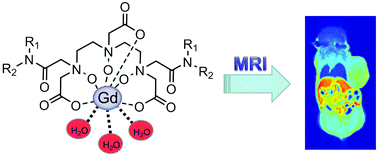Gadolinium complexes of diethylenetriamine-N-oxide pentaacetic acid-bisamide: a new class of highly stable MRI contrast agents with a hydration number of 3†
Abstract
Complexes of gadolinium(III) have proven to be especially effective magnetic resonance imaging (MRI) contrast agents. One essential strategy to achieve more sensitive small-molecule gadolinium-based MRI contrast agents is to increase the hydration number q in order to improve the relaxivity. In this work, a series of diethylenetriamine-N-oxide pentaacetic acid-bisamide-based Gd(III) complexes with 3 coordinated water molecules have been synthesized, in which the hydration numbers are verified by luminescence measurements. Relaxivities of all the complexes are about triple of those commercial MRI contrast agents, ranging from 12.5 to 18.8 mM−1 s−1 (1.5 T; 25 °C). The formation constants of the Gd(III) complexes were calculated from potentiometric titration data at 25 °C using the HYPERQUAD program, which demonstrate superior stability over the commercial MRI contrast agent Gd-DTPA-BMA (Omniscan®). The kinetic inertness of the complexes was also higher than Omniscan® and comparable to another commercial MRI contrast agent Gd-DTPA (Magnevist®). Meanwhile, the viability of HeLa cells remained unaffected after the exposure to the complexes. The efficacy of these complexes as potential positive contrast agents in MRI was further evaluated using in vivo studies, and the complexes were found to exhibit superb positive contrast.



 Please wait while we load your content...
Please wait while we load your content...